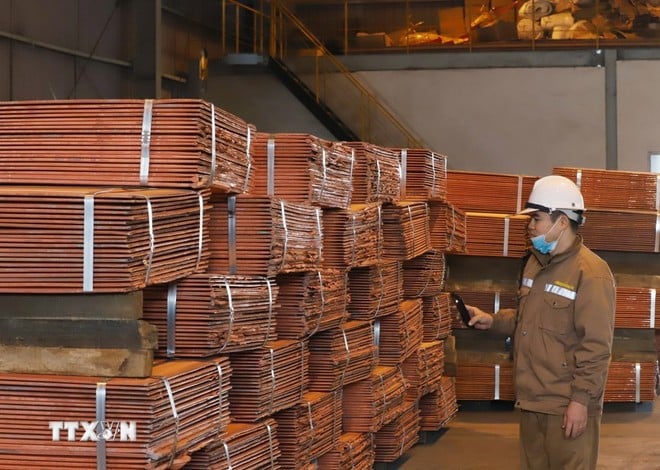At the close of trading on Friday, COMEX copper prices recorded a weekly increase of nearly 11%, reaching 12,356 USD/ton; meanwhile, LME copper prices lost more than 2%, falling to 9,661 USD/ton.

According to the Vietnam Commodity Exchange (MXV), the tug-of-war sentiment continued in the world raw material market last week.
Notably, in the metal and agricultural markets, while the metal group led the upward momentum for the entire market, on the contrary, the agricultural group closed in red.
At the end of the week, dominant buying power supported the MXV-Index to increase 0.3% compared to last week, reaching 2,229 points.
At the end of the trading week, the price of metal commodities was mixed with green and red. At the end of the trading session on Friday, COMEX copper prices recorded a weekly increase of nearly 11%, reaching 12,356 USD/ton. Meanwhile, LME copper prices lost more than 2%, falling to 9,661 USD/ton.
According to MXV, since late February of this year, after US President Donald Trump directed the Department of Commerce to open an investigation into copper imports for national security reasons, a wave of hoarding has occurred strongly in the US. COMEX copper prices have set many increasing chains and record highs.
Most recently, on July 9, Mr. Trump suddenly announced that he would impose a 50% tax on all imported copper starting August 1, making the price of copper even more expensive.
The United States imports nearly half of the copper — a metal widely used in machinery, electronics, household goods, and construction — that it consumes.
Earlier, on Tuesday, July 8, copper prices in the US increased by 13%, marking the strongest increase since 1989, closing at a record of 12,445 USD/ton. Meanwhile, copper prices on the LME in London increased by only 0.3%.
The premium of copper prices on the COMEX floor compared to copper prices on the LME in the trading session on Friday (July 11) was up to 26.7%, equivalent to a difference of more than 2,600 USD/ton.
By August this year, when the US's 50% tariff on copper takes effect, US consumers could be paying $15,000 a tonne for copper, while the rest of the world will pay $10,000 a tonne, according to Benchmark Mineral Intelligence.
On the other hand, copper consumption in the US is still under great pressure due to the decline in the manufacturing sector. Last June, the US manufacturing purchasing managers index (PMI) was 49 points, continuing to record the fourth consecutive month of decline, reflecting the prolonged contraction of domestic industrial production activities. This contributed to restraining the increase in copper prices.

On the Vietnamese side, according to data from the International Trade Center (ITC), in 2024, Vietnam will only export about 14.7 tons of scrap copper and 42.8 tons of refined copper to the US.
This export volume accounts for a very small proportion of Vietnam's total copper export turnover, showing that the level of dependence on the US market is insignificant.
The past trading week witnessed overwhelming selling pressure in the agricultural market when all 7 items in the group weakened simultaneously. Of which, corn prices decreased by 5.7% compared to the end of last week to 155.9 USD/ton.
According to MXV, the prospect of abundant supply while the impacts from tariff policies have caused market demand to remain uncertain has caused prices of this commodity to drop sharply last week.
The progress of harvesting the second corn crop - Brazil's main corn crop - is being strongly promoted in the first days of July. According to data from AgRural, as of July 3, Brazil has completed harvesting 28% of the second corn crop area, an increase of 10% compared to last week.
Brazil’s second corn crop is forecast by many organizations to reach a record level, ranging from 131 to 133 million tons depending on the assessment unit. Brazil’s second corn crop is expected to start hitting the market in September.
In Argentina, corn harvest is also accelerating. According to the Buenos Aires Grain Exchange, the 2024-25 corn harvest is 70.4% complete.
Argentina is currently the world's third largest corn exporter, with output expected to reach 49 million tonnes this crop year.
Notably, the Argentine Large Agricultural Association (SRA) said that farmers in this country are tending to shift their priority to growing corn instead of soybeans for the 2025-2026 crop year.
The main reason is that soybeans are taxed higher, and their prices and margins are lower than corn. Currently, corn is taxed at 12% in Argentina, while soybeans are taxed at 33%.
The USDA Crop Progress Report also shows that this year's corn crop in the US is in the best condition since 2018. Specifically, 74% of the corn area is rated as good to excellent. This year's corn area reached 38.5 million hectares, the highest in the past decade. USDA forecasts this year's corn production will reach 401.32 million tons.

The abundant corn supply is also reflected in active export activities. In the week ending July 3, U.S. corn exports reached 1.49 million tons, up 7.97% from the previous week and 45.6% higher than the same period last year, mainly to markets such as Mexico, Japan and South Korea.
Meanwhile, China - the world's largest corn importer - is likely to reduce imports next crop year as the country has just had a bumper harvest.
According to a report from the USDA, China's corn output is expected to reach 296 million tons in the 2025-2026 crop year, a slight increase of about 0.4% compared to the 2024-2025 crop year.
But the most worrying thing is that the tariff tension shows no signs of improving. This week, the US announced a 50% tariff on Brazil, causing the Brazilian Real to fall 2 percentage points against the USD, encouraging Brazilian producers to increase agricultural sales.
In addition, the tariff situation between the US and China has not improved, making investors worried about the future prospects of the world economy./.
Source: https://baolangson.vn/thi-truong-nguyen-lieu-the-gioi-tam-ly-tich-tru-day-gia-dong-comex-tang-manh-5053151.html





































































































Comment (0)